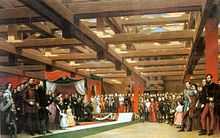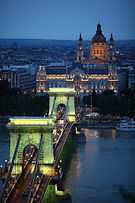Chain Bridge (Budapest)
| Chain Bridge | |
|---|---|
 | |
| Coordinates | 47°29′56″N 19°02′37″E / 47.49889°N 19.04361°ECoordinates: 47°29′56″N 19°02′37″E / 47.49889°N 19.04361°E |
| Carries | two road lanes |
| Crosses | Danube River |
| Locale | Budapest |
| Official name | Széchenyi Lánchíd |
| Other name(s) | Lánchíd |
| Characteristics | |
| Design | chain Suspension bridge |
| Material | wrought iron and stone[1] |
| Total length | 375 metres (1,230 ft) |
| Width | 14.8 metres (49 ft) |
| Longest span | 202 metres (663 ft) |
| History | |
| Designer | William Tierney Clark |
| Construction begin | 1840[1] |
| Construction end | 1849[1] |
| Opened | November 20, 1849 |
 Chain Bridge Location in Budapest | |

The Széchenyi Chain Bridge (Hungarian: Széchenyi lánchíd, Hungarian pronunciation: [ˈseːt͡ʃeːɲi ˈlaːntshiːd]) is a suspension bridge that spans the River Danube between Buda and Pest, the western and eastern sides of Budapest, the capital of Hungary. Designed by the English engineer William Tierney Clark, it was the first permanent bridge across the Danube in Hungary, and was opened in 1849.
It is anchored on the Pest side of the river to Széchenyi (formerly Roosevelt) Square, adjacent to the Gresham Palace and the Hungarian Academy of Sciences, and on the Buda side to Adam Clark Square, near the Zero Kilometre Stone and the lower end of the Castle Hill Funicular, leading to Buda Castle.
The bridge has the name of István Széchenyi, a major supporter of its construction, attached to it, but is most commonly known as the Chain Bridge. At the time of its construction, it was regarded as one of the modern world's engineering wonders. It has asserted an enormous significance in the country's economic, social and cultural life, much as the Brooklyn Bridge has in New York and United States of America. Its decorations made of cast iron, and its construction, radiating calm dignity and balance, have elevated the Chain Bridge to a high stature in Europe. It became a symbol of advancement, national awakening, and the linkage between East and West.
History


The bridge was designed by the English engineer William Tierney Clark in 1839, after Count István Széchenyi's initiative in the same year, with construction supervised locally by Scottish engineer Adam Clark (no relation). It is a larger scale version of William Tierney Clark's earlier Marlow Bridge, across the River Thames in Marlow, England.
It was funded to a considerable extent by the Greek merchant Georgios Sinas who had considerable financial and land interests in the city and whose name is inscribed on the base of the south western foundation of the bridge on the Buda side.
The bridge was opened in 1849, and thus became the first permanent bridge in the Hungarian capital, after the Hungarian Revolution of 1848. At the time, its center span of 202 metres (663 ft) was one of the largest in the world. The lions at each of the abutments were carved in stone by the sculptor, János Marschalkó.[2] They are visibly similar in design to the famous bronze lions of Trafalgar Square by Edwin Henry Landseer with Marochetti (commissioned 1858, installed 1867), but they were earlier - installed 1852.[3] They are also smaller (and appear from below to lack tongues). The bridge was given its current name in 1898.
It was designed in sections and shipped from the United Kingdom to Hungary for final construction.
The bridge's cast iron structure was updated and strengthened in 1914. In World War II, the bridge was severely damaged during the Siege of Budapest, and was rebuilt and reopened 1949.
In popular culture
In 2001, Hungarian stunt pilot Péter Besenyei flew upside down under the bridge, a maneuver that became a standard in Red Bull air races today. The bridge is featured in the 2002 movie I Spy. Also, in Katy Perry's music video Firework, it is featured at the beginning. The climax scene in Bollywood blockbuster Hum Dil De Chuke Sanam was shot on this bridge.
The inscription on each side of the bridge is to Clark Adam, a Hungarian name using Eastern Name Order, one of very few British names that have been placed in that order.
A plaque on the Pest side of the river reads "To commemorate the only two surviving bridges designed by William Tierney Clark: The Széchenyi Chain Bridge over the Danube at Budapest and the suspension bridge over the Thames at Marlow, England."
The bridge featured prominently Matthew Barney's Cremaster 5, serving as a reference to Harry Houdini.
Image gallery
-

One of the guardian lions (with his tongue hidden)
-

Chain Bridge with Royal Castle in the back
-

The bridge in sunset
-

The bridge with green colors, few seconds after it's been lit up
-

On the bridge by night
See also
- List of crossings of the Danube River
References
External links
| Wikimedia Commons has media related to Chain Bridge (Budapest). |
- Széchenyi Chain Bridge at Structurae
- Hungarian Electronic Libraries' entry on Hungarian bridges
- Bridges of Budapest - Chain Bridge
| ||||||||||||||